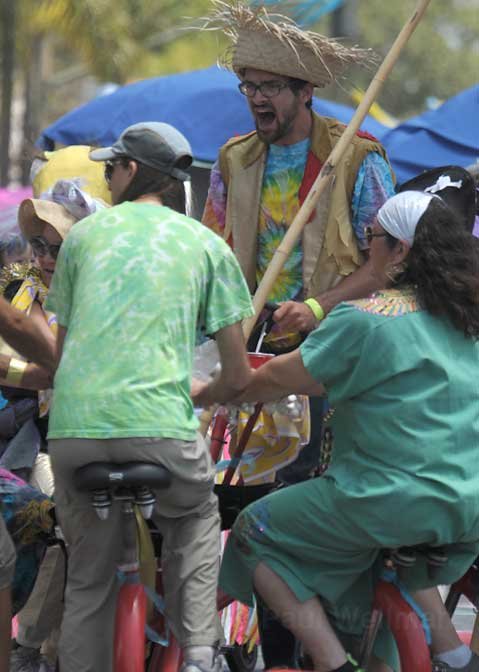Block That Jam!
Why Is City Council “Planning” for Increased Traffic?

Next week, City Council will either take four years of our community’s input and steer Plan Santa Barbara wisely into the future, or balk, like a pitcher who can’t seem to let go of the baseball.
Come decision time, the City of Santa Barbara’s newly elected political minority will have the power to, and may indeed, determine that traffic congestion is a more politically expedient choice than managing responsibly for traffic reduction, economic vitality, and parking availability. We know traffic will get worse, but some in our political leadership are electing to kick the can down the road until it gets as bad as our best projections show it will. By that time, they seem to hope, we’ll be foolish enough to blame the problem on someone else.

This thinking defeats the spirit and intent of Santa Barbara’s comprehensive, updated, 20-year general plan. It pays a disservice to all the citizens who invested their time to contribute to it. The traffic-reduction strategies included in late drafts of the plan are tied directly to our community’s well-being. Without them, traffic congestion and its resultant dangers, to the public and our local economy, will increase. Throughout the four years of the Plan Santa Barbara process, citizens, merchants, and community groups have spoken out about the need to reduce traffic, minimize neighborhood impacts, and make our streets and sidewalks safer. This input both drove and helped to continually revise the plan. Again and again, Santa Barbarans got out of work early, hired a babysitter, and so on, in order that their voices could be heard.
Now, in this final stage, Plan Santa Barbara is entirely in the hands of City Council, at whose feet it will be laid on Tuesday, October 26, with a public hearing to start at 2 p.m. and continuing Wednesday. Perhaps in an effort to ensure the five-out-of-seven required votes at City Council, the Santa Barbara Planning Commission’s final “hybrid alternative” sidesteps the issue of future traffic problems. It undercuts traffic-reduction solutions. In its current form, the hybrid plan will significantly increase congestion while putting a freeze on the tools that can effectively deal with it.
The hybrid plan acknowledges we will have more congestion. More intersections will become jammed during the morning and evening rush hours. Indeed, traffic is expected to increase 10 percent during the morning peak, and 10 to 13 more intersections will move to an unacceptable level of service.
The intersections that are already failing will get worse. While longer distance commuters currently experience most traffic jams, traffic impacts are projected to shift more to local streets, and to local residents. For example, traffic on key intersections such as Carrillo and San Andres, and La Cumbre and State, are likely to become much more severe. Unchecked, gridlock could send short-cut-seeking commuters racing down your residential side streets trying to get ahead. It’s not exactly the “livable communities” scenario we’d all hoped for.
We currently have an off-kilter downtown parking arrangement. The abundant parking garages work great for short-trip visitors and shoppers. But on-street parking is tough. The fine for overstaying one’s time on the street (typically 75 minutes, though there are also 15-minute and 90-minute spaces) is currently $45. That’s no small change. If you are a customer, it’s reason enough not to come back. And employees are caught in a system that, outside of our two commuter parking lots, treats them as an afterthought, encouraging a game of parking shuffle that severely penalizes anyone caught parking past the 75-minute limit.
Business districts in many other cities have learned that one way to keep customers in their stores, and ensure that the limited on-street parking turns over frequently, is to allow motorists to select how long they need to stay on the street and pay accordingly. But certain players here refuse to even discuss something that has proven itself an invaluable asset to business districts elsewhere.
When cities price parking to ensure that there is always some on-street parking available for customers, a happy side effect occurs. Congestion goes down. Not only is there less circling the block for parking spots, but some employees opt to walk, bike, bus, or carpool to work. Findings from other cities show that effective parking management is good for business, good for traffic circulation, and good for encouraging active transportation. (By active transportation, I mean walking four blocks instead of re-parking, biking in one or two miles to, say, the farmers market or the store, or even taking MTD in and walking the few blocks between the bus stop and end destination.) Nothing about this takes away parking away; it simply puts a nominal price on the most impacted on-street parking spaces in the city.
While it may be a hard political choice for some, our civic leaders in City Council and the Downtown Organization should feel compelled to reconsider meters and other parking management strategies in our downtown core. For better or worse, traffic and parking there are directly linked with traffic and parking throughout the city. They are also linked to our long-term economic vitality. We need to be making informed decisions, not hiding behind the sacred cow of “free” on-street parking.
What’s needed right now is leadership in making hard decisions. We can’t allow the Santa Barbara City Council to kick the traffic-jam can down the road. It’s time to hold councilmembers accountable for maintaining one of our more important longstanding traditions: No increased traffic in our residential neighborhoods! Put congestion and parking management strategies back into Plan Santa Barbara!
Edward G. France serves as vice chair of the City of Santa Barbara’s Transportation and Circulation Committee.



